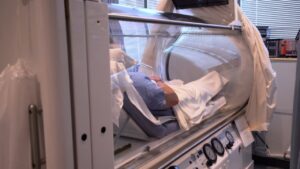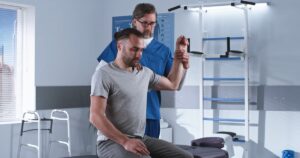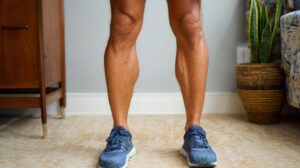Flat feet can cause a lot of questions—and sometimes worry—for parents. You notice your child walking a little differently or complaining about their legs after playing, and suddenly you’re scanning shoes, arches, and every footprint in the sand.
The truth? Most of the time, flat feet in kids aren’t something to panic about. But there are situations where it’s worth paying closer attention.
Let’s walk through what’s going on, what to look for, and what actually helps.
Key Points
- Most kids with flexible flat feet don’t need treatment unless they’re in pain or walking awkwardly.
- Rigid flat feet are less common and may signal underlying conditions needing specialist care.
- Orthotics, physical therapy, and proper shoes help when symptoms show up.
- Surgery is rare and only used when pain is chronic and other treatments fail.
The Two Main Types of Flat Feet in Kids
| Type | Description | Common Causes |
| Flexible Flat Feet | Arch is visible when not standing, but flattens under weight | Often hereditary, associated with hypermobility |
| Rigid Flat Feet | Arch is absent at all times, even when off weight | May be linked to structural or neurological conditions (e.g. tarsal coalition, cerebral palsy) |
- Flexible flat feet are by far the most common and generally harmless. Kids might not even notice them unless there’s pain.
- Rigid flat feet, on the other hand, tend to be stiffer, sometimes painful, and may be connected to something more significant.
According to Foot Health Facts, if there’s no discomfort, most children with flat feet don’t need treatment. But if pain, fatigue, or awkward walking patterns show up, it’s time to investigate.
How Doctors Spot Flat Feet in Kids

Diagnosis usually starts with a physical exam. A pediatrician, orthopedist, or podiatrist will take a good look at how your child’s feet move when standing, sitting, tiptoeing, and walking.
What the Doctor Looks At:
- Standing vs. sitting: Does the arch appear when your child sits or goes on tiptoes? That’s a good sign of flexibility.
- Walking gait: Are they rolling their ankles inward? Is their stride unusual?
- Pain points: Are they complaining about their feet, knees, or lower back?
If the situation seems more than developmental, further tests might include:
- Foot Posture Index (FPI-6): A tool used to assess overall foot alignment.
- Arch height or navicular drop tests: Quantitative measurements of how much the arch lowers under pressure.
- Footprint analysis: Traditional ink methods or digital scans can help visualize pressure points and weight distribution.
- X-rays, CTs, or MRIs: Used if there’s stiffness, pain, or suspected abnormalities like fused bones or tendon problems.
The goal is to determine whether the flat foot is flexible or rigid and whether it’s causing issues that need attention.
When Flat Feet Are No Big Deal
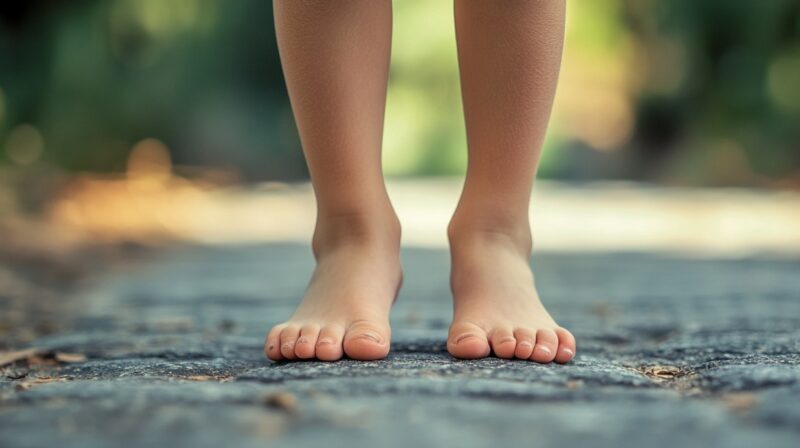
Most children with flexible flat feet don’t have pain, don’t struggle with movement, and go on to develop normal arches or just live flat-footed without a problem.
In such cases, doctors usually recommend no treatment at all—just good shoes and some watchful waiting.
For asymptomatic kids:
- Skip the orthotics unless advised by a specialist.
- Stick to shoes with good structure (nothing too flimsy or loose like flip-flops).
- Let kids play as usual—there’s no need to limit activities if there’s no pain or mobility issue.
In fact, trying to “fix” a flexible flat foot that isn’t causing problems might just cause unnecessary stress (and expense).
A study by James B. Carr II found that flatfoot prevalence drops from ~97% at age 2 to ~4% by age 10, demonstrating natural arch development during childhood
When Treatment Makes Sense
When children start to complain, whether it’s heel pain, tired legs after sports, or an odd walking pattern, it’s time to step in.
Here’s what actually helps:
Orthotic Devices
Orthotics are custom or semi-custom inserts placed in the shoe to provide better support.
- Custom orthotics are ideal for severe or specific foot shapes.
- Prefabricated inserts may be enough for mild symptoms.
- In tough cases, something more rigid like the UCBL brace can help stabilize foot alignment.
Physical Therapy
Strengthening and stretching exercises are often a game changer.
- Focus on the tibialis posterior muscle—it helps support the arch.
- Stretch tight Achilles tendons and calves, which often pull the heel out of alignment.
- Include balance exercises for overall foot control and coordination.
Proper Footwear
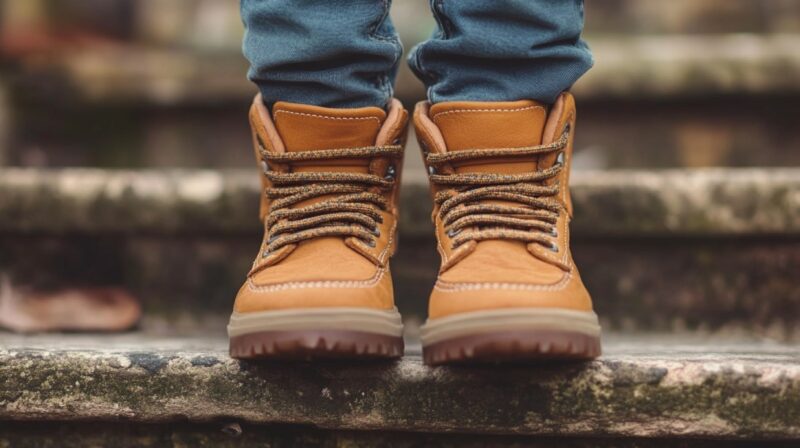
- Choose barefoot-style sneakers with a secure heel and a flexible yet protective sole — brands featured on this site prioritize foot-shaped design and natural movement.
- Avoid barefoot walking on hard surfaces for long periods.
- Stay away from shoes with no structure—think ballet flats, moccasins, or soft slip-ons.
Activity Adjustment
If your child is limping or regularly tired after activity, scale things back temporarily.
- Limit prolonged standing, long runs, or high-impact sports until things improve.
- Encourage low-impact movement like biking or swimming during recovery periods.
Medications
Over-the-counter ibuprofen or similar anti-inflammatories can ease pain during flare-ups, but they’re not a long-term fix.
When Surgery Enters the Conversation
Surgery is the last resort, and it’s a big one. According to research, it’s only considered when:
- Pain is chronic and affects quality of life.
- All non-surgical approaches have failed.
- The foot is structurally abnormal and limiting function.
Surgical options vary depending on the cause and severity:
- Tendon transfer or lengthening: Helps with muscle imbalance or tight tendons.
- Reconstructive surgery: Rebuilds the arch and realigns bones.
- Arthroereisis: Places a small implant to support the arch under the talus.
- Arthrodesis: Fuses bones together in extreme cases for stability.
There’s some disagreement in the medical world about how early to operate or whether to operate at all unless function is severely affected. That’s why a second opinion—preferably from a pediatric orthopedic specialist—is always wise before committing to surgery.
It is also recommended that you use natural alternatives for painkillers if your child needs them.
What Parents Can Do Right Now
- Limping or unusual gait
- Fatigue after walking or running
- Foot, ankle, or knee complaints
- Preference for sedentary activities
- Outward rolling ankles (overpronation)

Support smart footwear choices:
- Good brands to consider: New Balance, Asics, Saucony, Stride Rite
- Avoid super flexible or unsupportive shoes unless worn for short periods only
- Replace shoes when worn down—flattened soles don’t provide the same support
Make playtime smart:
- Mix in balance games, soft sand or grass walking, and climbing activities to naturally engage foot muscles
- Encourage barefoot time at home on soft surfaces—but avoid it on concrete or tile
The Long-Term Outlook
Here’s the reassuring part: most kids with flat feet don’t need treatment and don’t develop long-term problems.
- For flexible flat feet, arches often appear by adolescence.
- Even when arches don’t form, the condition often remains harmless and doesn’t affect physical abilities.
- Kids with rigid flat feet might need extra support, but with proper care, they can stay active and pain-free.
Regular check-ups are helpful to track changes, especially during growth spurts or sports seasons when the body’s under more stress.
Final Thoughts
Flat feet can look dramatic, especially when the entire foot is planted flat like a pancake. But most of the time, it’s just part of normal development. When kids do need help, simple tools like orthotics, better shoes, or some strengthening exercises can make a big difference.
The key is paying attention without panic. If your child isn’t in pain, odds are they’re doing just fine. But if something feels off, getting it checked out early can keep small problems from growing bigger.
You don’t need to become a foot expert overnight. Just stay tuned into how your child moves—and trust your gut if something doesn’t seem right.
Related Posts:
- Contracted Gallbladder-Diagnosis and Treatment!
- How to Make a Surgical Room More Comfortable for Children
- How Long Does It Take for Magnesium Citrate to Work?
- 10 ADHD Management Tips That Actually Work Day to Day
- Gallbladder Calculus and Acute Cholecystitis -…
- What is Incarcerated Hernias? - Causes, Symptoms,…









